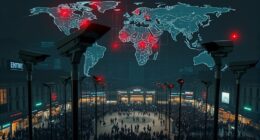The Cold War reshaped how Russia and the U.S. approached espionage, moving from human intelligence to digital strategies. Both nations invested heavily in technology, leading to advanced surveillance and hacking techniques. This shift laid the groundwork for modern cyber warfare and AI-driven intelligence operations. The legacy of their cyber tactics continues to influence today's threats and capabilities. Discover how these historical developments inform current practices in the evolving landscape of intelligence gathering.
Key Takeaways
- The Cold War transitioned espionage from HUMINT to digital methods, paving the way for AI-driven intelligence operations.
- Both the U.S. and Russia heavily invested in technological advancements, establishing foundational tools for modern cyber warfare.
- Cyber warfare emerged as a strategic military capability, replacing traditional confrontations and facilitating data-driven intelligence gathering.
- AI technologies enhance surveillance and data processing, significantly transforming intelligence operations and military strategies.
- Ethical concerns around AI's use in intelligence include privacy violations, biased algorithms, and the potential for autonomous cyber attacks.
The Birth of Cyber Warfare: A Historical Perspective
As the Cold War intensified, both superpowers realized that the battlefield was no longer confined to physical confrontations; it extended into the domain of technology and information.
The period marked the birth of cyber warfare, with the U.S. and the Soviet Union investing heavily in technological advancements to bolster their intelligence operations. You'd see the U.S. establish ARPANET in the late 1960s, paving the way for the internet and opening new avenues for information warfare.
Meanwhile, agencies like the KGB and CIA engaged in electronic surveillance and communication interception to gain strategic advantages.
Espionage Techniques: From Human Intelligence to Digital Spying
While the Cold War initially relied on traditional espionage methods like human intelligence (HUMINT), the landscape shifted dramatically with the advent of digital technologies.
You saw intelligence agencies like the KGB and GRU leverage these advancements, employing new espionage techniques such as wiretapping and electronic surveillance.
As computers and the internet emerged, both the U.S. and Russia engaged in sophisticated digital spying, exemplified by incidents like the 2016 election interference.
The Cold War laid the groundwork for modern tactics, emphasizing the strategic importance of cyber capabilities.
Recruitment of tech-savvy individuals became essential, and disinformation campaigns flourished, manipulating public perception through digital platforms.
This evolution marked a pivotal transformation in how nations gather and utilize intelligence.
The Role of Technology in Cold War Intelligence Operations
Technology played an essential role in shaping intelligence operations during the Cold War, fundamentally altering how both the U.S. and Soviet Union gathered information. Both nations heavily invested in technological advancements, including early computer systems, to enhance their intelligence agencies' capabilities.
The KGB's sophisticated methods for covert operations utilized cutting-edge technology for surveillance and data collection, paving the way for modern practices. As cyber espionage emerged, both superpowers recognized the potential of computer networks for infiltration and data theft.
The U.S. implemented advanced signal intelligence technologies, like the EC-121 Warning Star, to intercept Soviet communications. This technological arms race laid the groundwork for contemporary espionage techniques, where artificial intelligence now plays an essential role in data analysis and predictive intelligence. Furthermore, the impact of automation has transformed how intelligence is processed, enabling faster and more accurate decision-making based on large datasets.
Key Players: The CIA and KGB's Cyber Strategies
The intelligence landscape during the Cold War was dominated by two key players: the CIA and the KGB. Both agencies leveraged emerging technologies, shaping their cyber strategies to gain an edge in espionage.
- CIA focused on sophisticated hacking techniques to gather intelligence.
- KGB excelled in disinformation campaigns, using radio communications to manipulate data.
- Both invested heavily in research and development, blending technology with psychological tactics.
Intelligence officers from these agencies engaged in a fierce competition, with the CIA pursuing technological innovation while the KGB emphasized psychological warfare.
This rivalry not only defined their operations but also laid the groundwork for modern cyber warfare and artificial intelligence in intelligence operations for Russia and the U.S. in later decades.
The Evolution of Data Manipulation: Lessons From the Past
As nations vied for dominance during the Cold War, the manipulation of data became a powerful tool in the intelligence arsenal. Both the U.S. and Soviet Union engaged in extensive espionage, employing data manipulation to gain strategic advantages.
Russian intelligence, particularly through the KGB, executed disinformation campaigns that effectively shaped public perception and undermined Western interests. These covert operations set a precedent for modern tactics, illustrating how controlling narratives can influence geopolitical outcomes.
The rise of computer technology further evolved data manipulation, paving the way for sophisticated cyber espionage techniques. Lessons from this era stress the need for vigilance against information manipulation, as strategies initially developed for espionage are now adapted for the digital age, including AI-driven methods.
Legacy of Cold War Espionage in Today's Cyber Landscape
While many might think of espionage as a relic of the past, its legacy from the Cold War is alive and well in today's cyber landscape. Russian intelligence agencies, particularly the GRU, have adapted strategies from that era, transforming traditional espionage into sophisticated cyber operations.
This shift highlights key elements of Cold War tactics that remain relevant:
- Covert operations are now digital, targeting U.S. political organizations and essential infrastructure.
- Disinformation campaigns manipulate public perception, echoing KGB practices.
- Cyberattacks reflect the lessons learned about information control as critical to national security.
As we navigate this complex landscape, understanding the Cold War's impact on modern intelligence gathering becomes imperative to safeguarding against advanced threats.
The Intersection of AI and Modern Intelligence Gathering
As you explore the intersection of AI and modern intelligence gathering, you'll see how AI-enhanced surveillance techniques reshape espionage practices.
Autonomous decision-making powered by AI raises questions about accountability and ethics in intelligence operations.
Understanding these dynamics is essential for grasping the implications of technology on national security.
AI-Enhanced Surveillance Techniques
With the rise of artificial intelligence, modern intelligence gathering has undergone a significant transformation, particularly in surveillance techniques.
AI-enhanced surveillance allows agencies to process immense data and identify patterns rapidly. Russian spies and U.S. agencies like the NSA now rely on advanced tools that offer:
- Real-time facial recognition and behavioral analysis for improved threat detection
- Automated systems that sift through communications to pinpoint vulnerabilities
- AI-driven predictive analytics that forecast potential security threats based on social media trends
These innovations not only streamline reconnaissance missions but also enable autonomous drone operations that can monitor targets without human input.
As AI continues to evolve, its role in surveillance will only deepen, reshaping the landscape of intelligence gathering.
Autonomous Decision-Making in Espionage
The rise of AI-enhanced surveillance techniques has paved the way for a new era in espionage, where autonomous decision-making plays a pivotal role. Russian intelligence employs these advancements to analyze vast data, identifying patterns and threats at unprecedented speeds. AI-driven systems autonomously monitor communications and social media, while machine learning algorithms improve predictive analytics, forecasting adversary actions based on historical data. Autonomous hacking tools execute complex cyber operations without direct human input, markedly increasing the scale of espionage.
| Technique | Functionality | Impact |
|---|---|---|
| Autonomous Surveillance | Monitors communications in real-time | Enhances threat detection |
| Predictive Analytics | Forecasts adversary actions | Improves strategic planning |
| Cyber Operations | Executes attacks autonomously | Increases speed and scale |
| Data Analysis | Identifies patterns faster than humans | Enhances intelligence gathering |
Ethical Implications of AI
While integrating AI into intelligence gathering offers significant advantages, it also raises important ethical concerns that can't be ignored.
The intersection of AI and national security poses several dilemmas that challenge our understanding of privacy and civil liberties.
- AI can process personal data without consent, risking individual rights.
- Biased algorithms may lead to discriminatory surveillance practices, reflecting societal prejudices.
- The use of AI in disinformation campaigns can undermine democratic processes.
As you explore these ethical implications, it's vital to push for international norms that safeguard human rights while addressing the pressing need for effective intelligence operations.
Balancing these priorities is fundamental to ensuring technology serves the public good rather than undermining it.
Implications for National Security in the Digital Age
As cyber threats evolve, understanding the implications for national security in the digital age becomes essential. Russian intelligence has shown that cyber espionage can directly threaten election integrity and manipulate public perception. With AI advancing, adversaries can launch sophisticated attacks that complicate traditional defense strategies. The recent Microsoft outage highlighted the vulnerabilities that can be exploited during critical disruptions.
| Challenge | Implication for National Security |
|---|---|
| Evolving Cyber Espionage | Increased need for updated protocols and defenses |
| AI-Driven Disinformation | Difficulty in discerning truth from manipulation |
| Historical Espionage Tactics | Necessitates innovative approaches to counter threats |
To protect national security, continuous vigilance and adaptation are vital in this rapidly changing landscape.
Frequently Asked Questions
Did the US Have Spies in Russia During the Cold War?
Yes, the U.S. had spies in Russia during the Cold War. They employed various tactics, including human intelligence and signals intelligence, to gather essential information on Soviet activities.
Notable spies, like Aldrich Ames and Robert Hanssen, compromised many operations by leaking sensitive details. Additionally, advanced technology, such as U-2 spy planes and satellites, played an important role in intercepting communications.
These efforts heightened geopolitical tensions and underscored the high stakes of espionage during that era.
How Did the Cold War Affect US Intelligence?
The Cold War substantially shaped U.S. intelligence by driving advancements in technology and espionage techniques.
You'll notice how electronic surveillance and satellite reconnaissance became crucial tools to gather information.
The urgency to counter threats from the Soviet Union led to the establishment of sophisticated programs, including the CIA's Project X.
This focus on innovation and cyber capabilities laid the groundwork for modern intelligence operations, emphasizing the importance of data analysis and cryptography in national security.
How Did Spies Play a Role in the Cold War?
Spies played an essential role in the Cold War, shaping events you mightn't even realize. They gathered critical intelligence, turning the tide in key moments.
You'd see them infiltrate enemy lines, sharing secrets that influenced military strategies. Their covert operations, from wiretapping to disinformation, created an atmosphere of mistrust.
These actions not only escalated tensions but also sparked advancements in espionage technology, setting the stage for the complex intelligence world you know today.
What Was the Russian Spy Agency During the Cold War?
During the Cold War, the primary Russian spy agency was the KGB, or the Committee for State Security. Established in 1954, it specialized in espionage, counterintelligence, and maintaining state security.
You'd find the KGB conducting covert operations globally, using tactics like surveillance and infiltration to protect Soviet interests. Its notorious activities included recruiting agents in Western governments and executing high-profile assassinations, leaving a lasting impact on intelligence practices in Russia today.
Conclusion
As we navigate today's digital battlefield, it's amusing to think that the Cold War's spies, who relied on face-to-face deception, now watch AI do their job. You'd think all those years of human cunning would be enough, but here we are, entrusting our secrets to algorithms. Ironically, the very technology born from those tense times now shapes our intelligence landscape, proving that while we've advanced, the game of espionage remains as timeless as ever.







